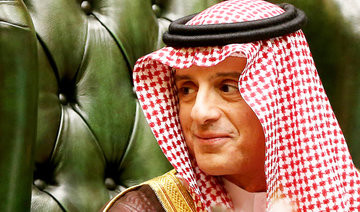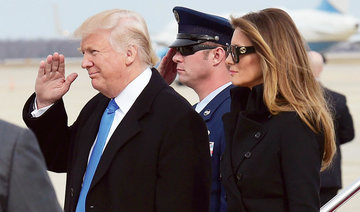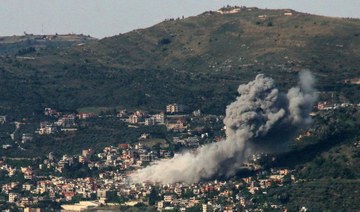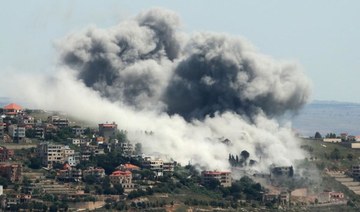WASHINGTON: Some American pundits argue that US President Donald Trump’s most notable achievement in his first year in office came in the waning days of December, when Trump and the Republican majority in the US Congress succeeded in overhauling the US tax code. The centerpiece of the most significant tax reform in decades is a reduction in the rate of corporate taxes. It represents a significant philosophical shift and a return to the supply-side economics that have become synonymous with the presidency of Ronald Reagan. The tax bill will likely loom large in Trump’s legacy. However, that does not mean that 2017 was not a seminal year in American foreign policy as well.
While overshadowed by the passing of the aforementioned tax legislation, the Trump administration released a 70-page National Security Strategy (NSS) earlier this week which outlines what it considers to be the main threats to US national security and the strategies it has adopted to confront them. Whereas few observers spoke with any degree of certainty at the beginning of the year about what the contours of a “Trump doctrine” would look like, the administration’s actions and statements during its first year, in addition to the release of the NSS, have answered many important questions. As 2017 comes to a close, we have a reasonably good idea about how Trump views the world and the role the US should play in it.
Perhaps more than any other single phrase uttered by Trump during his inaugural address in January, “America first” received an inordinate amount of attention from analysts both inside and outside the US. And while some interpreted it as a shift to unilateralism, or even isolationism, a review of the Trump administration’s record during the course of its first year, as well as a careful reading of the NSS, suggests that is not the case.
Trump sent a clear and powerful message to the Middle East and the world when he decided to make Saudi Arabia the destination of his first official overseas trip. The NSS explicitly states that combating terrorists, countering the “domination” of hostile powers, and ensuring “a stable energy market” are America’s main objectives in the Middle East. Nevertheless, it was implicit in his visit to Riyadh that the US had no intention of disengaging from the world in general or from the Middle East in particular.
Trump has consistently said that combating and defeating violent extremists and terrorist groups including Daesh and Al-Qaeda was among his top foreign policy priorities. His choice of Saudi Arabia as the location from which he issued a call to the Islamic world to unite in its rejection of Daesh’s culture of death was an auspicious start to his foray into foreign affairs. In Riyadh, he stressed that Islamic countries must strengthen their efforts to eject extremists who distort the tenets of Islam to achieve political ends. His choice of Riyadh also indicated a solid grasp of the important leadership role that Saudi Arabia plays in the Islamic world. It suggested that the Trump administration understood that no unilateral measure — military or otherwise — would be enough to defeat the threat of terrorist groups. Daesh and Al-Qaeda have waged a war against all humanity and the international community must continue to work in tandem to counter and ultimately defeat this threat.
In Riyadh, Trump’s message to the Islamic world resonated well. However, critics argued that striking the right tone in a speech abroad is one thing, but what an administration does when it is confronted with a crisis is the ultimate test. Not surprisingly, that test came in Syria.
Trump’s predecessor, President Barak Obama, was widely criticized in 2013 for not adhering to his self-imposed “red line” against the use of chemical weapons in that war. His sudden reversal on not allowing the regime of Bashar Assad to use weapons of mass destruction against its civilian population with impunity confounded his critics and his supporters. Both expressed serious concerns about the ramifications of the reversal and what it meant for America’s credibility.
Faced with yet another well-documented incident of chemical-weapon use by Assad against civilians, including women and children, Trump proved resolute, as he ordered the US military to strike the air base from which the chemical attack on Idlib originated in April.
While the missile strikes were limited, they were praised by many in the Middle East for sending a strong message to Assad and for making it clear that the Trump administration believes the continuing political turmoil in the region calls for clarity, not ambiguity. Much like the leadership of Saudi Arabia, the US under Trump appears to believe that clear, resolute and assertive foreign policies are the correct approach to addressing the two main sources of insecurity in the region: Violent, non-state actors and their state sponsors.
True to its word, the US has continued to take the fight to Daesh in both Syria and Iraq. Playing an important supporting role to the government of Iraq, the US administration received high marks for staying the course and increasing its targeting of the remaining Daesh strongholds in Iraq. It has done the same in Syria, where it is supporting Arab and Kurdish forces. The two efforts have been successful enough for the terror group to lose virtually all of the territory it controlled in in both countries in 2014. The NSS makes clear that the administration will continue to work closely with its allies to defeat Daesh and other terrorist groups “by exposing its falsehoods, promoting counter-narratives, and amplifying credible voices.”
Trump also received high praise from officials and analysts in Saudi Arabia, Bahrain, the UAE and other Arab nations for his approach to what his administration has called Iran’s “nefarious activities” in the region. Trump and his top advisers and spokespeople have repeatedly made clear that they have adopted a very different philosophy to confronting Iran than that of Obama.
On multiple occasions, Trump officials have said that they will no longer draw a distinction between Iran’s destabilizing policies in the region, including its support of militant groups in Lebanon, Iraq, Yemen and elsewhere, and its adherence — or lack thereof — to the nuclear agreement Iran signed with six nations, including the United States, in 2015.
Trump has also refused to certify Iran’s compliance with that agreement. And while whether Iran is adhering to the terms of the agreement is a matter of dispute, there is little question that it has continued to flout international laws, conventions and norms by supporting militant groups and terrorist operations across the region and beyond.
The Trump administration and the US Congress have taken several measures to curtail the destabilizing activities of Iran’s Revolutionary Guards Corps and the Quds Force, especially the financing of their activities. America has also imposed additional economic sanctions on Hezbollah in Lebanon. It is safe to assume that members of Congress will pay even closer attention to Hezbollah next year, particularly in the aftermath of a lengthy — and controversial — article in the US media claiming that the Obama administration hampered the efforts of US law enforcement agencies trying to establish a link between Hezbollah and international drug cartels.
The Trump’s administration declaration of Jerusalem as the capital of Israel and its decision to move the US Embassy there from Tel Aviv have proven controversial. It is difficult, at this point, to see how these measures could advance peace negotiations between the Palestinians and Israelis. However, there is hope among some observers that the Trump team might bring a new approach to the now-stalled peace process. 2018 will likely prove pivotal in determining if the administration is successful.
Overall, the Trump administration receives high marks from many officials and analysts in the Arab world, and especially the member states of the Gulf Cooperation Council, who have argued — correctly — that an engaged United States is a force for good.
America’s political weight, military power and economic strength makes it uniquely positioned to help bring political stability to the Middle East and beyond. The Trump administration understands this reality. Its track record in the Middle East so far bodes well for the future of the region.
2017: A look back at Trump’s foreign policy in the Middle East
2017: A look back at Trump’s foreign policy in the Middle East
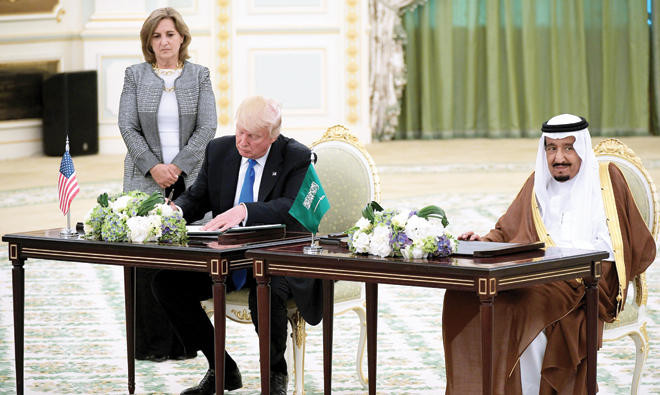
Israeli forces repeatedly target Gaza aid workers, says Human Rights Watch

- They are among more than 250 aid workers who have been killed in Gaza since the war erupted more than seven months ago, according to UN figures
- Israel has killed more than 35,000 Palestinians in Gaza, mostly women and children, according to the health ministry in the Hamas-run territory
JERUSALEM: Human Rights Watch said on Tuesday that Israel had repeatedly targeted known aid worker locations in Gaza, even after their coordinates were provided to Israeli authorities to ensure their protection.
The rights watchdog said that it had identified eight cases where aid convoys and premises were targeted, killing at least 15 people, including two children.
They are among more than 250 aid workers who have been killed in Gaza since the war erupted more than seven months ago, according to UN figures.
In all eight cases, the organizations had provided the coordinates to Israeli authorities, HRW said.
This reveals “fundamental flaws with the so-called deconfliction system, meant to protect aid workers and allow them to safely deliver life-saving humanitarian assistance in Gaza,” it said.
“On one hand, Israel is blocking access to critical lifesaving humanitarian provisions and on the other, attacking convoys that are delivering some of the small amount that they are allowing in,” Belkis Wille, HRW’s associate crisis, conflict and arms director, said in Tuesday’s statement.
HRW highlighted the case of the World Central Kitchen, a US-based charity who saw seven of its aid workers killed by an Israeli strike on their convoy on April 1.
This was not an isolated “mistake,” HRW said, pointing to the other seven cases it had identified where GPS coordinates of aid convoys and premises had been sent to Israeli authorities, only to see them attacked by Israeli forces “without any warning.”
EU top diplomat sees US ‘fatigue’ in Mideast

- Josep Borrell strongly criticized Israel’s war campaign, saying Gazans were ‘dying and starving and suffering in unimaginable proportions’ and that it was a ‘man-made disaster’
- Josep Borrell: ‘I see a certain fatigue from the US side to continue engaging in looking for a solution’
On a visit to California, the bloc’s foreign policy chief Josep Borrell again strongly criticized Israel’s war campaign, saying Gazans were “dying and starving and suffering in unimaginable proportions” and that it was a “man-made disaster.”
“I see a certain fatigue from the US side to continue engaging in looking for a solution,” Borrell said in a speech Monday at Stanford University that was publicly released on Tuesday.
“We are trying to push with the Arab people in order to build together, the Arabs and Europeans, to make this two-state solution a reality,” he said in English.
US Secretary of State Antony Blinken has made seven trips to the Middle East since the unprecedented October 7 attack on Israel by Hamas which prompted a relentless Israeli military campaign in Hamas-ruled Gaza.
He has nudged Israel to allow in more aid, pushed against a regional escalation and pleaded for Israel to accept a two-state solution as part of a broader eventual deal that includes normalization with Saudi Arabia.
But the United States vetoed a Security Council bid to give Palestine full UN membership, arguing that statehood can only come though negotiations that address Israel’s security concerns.
The General Assembly last week passed a symbolic vote for Palestinian membership with the United States one of only nine countries to vote against.
The others opposed included two European Union members — the Czech Republic and Hungary. Among EU heavyweights, France voted in favor and Germany abstained.
Borrell acknowledged that the vote showed the European Union was “very much divided” over Gaza, unlike on the Ukraine war, and cited “historical reasons.”
“But it doesn’t mean that we don’t have to take a stronger part of responsibility because we have delegated (to) the US looking for a solution,” he said.
Borrell, a former Spanish foreign minister, in February sharply criticized the US arms flow for Israel, pointing to President Joe Biden’s own words that too many people were dying in Gaza.
Biden last week for the first time threatened to cut military aid to Israel, with one shipment of bombs already halted, if Israel defies US warnings and assaults the packed city of Rafah.
‘Nothing wrong’ with Gaza death toll figures

- Israel has killed more than 35,000 Palestinians, according to Gaza’s Health Ministry
GAZA STRIP: The World Health Organization voiced full confidence in Gaza Ministry of Health death toll figures on Tuesday, saying they were actually getting closer to confirming the scale of losses after Israel questioned a change in the numbers.
Gaza’s Health Ministry last week updated its breakdown of the total fatalities of around 35,000 since Oct. 7, saying that about 25,000 of those have so far been fully identified, of whom more than half were women and children.
This sparked allegations from Israel of inaccuracy since Palestinian authorities had previously estimated that more than 70 percent of those killed were women and children.
UN agencies have republished the Palestinian figures, which have since risen above 35,000 dead, citing the source.
“Nothing wrong with the data, the overall data (more than 35,000) are still the same,” said WHO spokesperson Christian Lindmeier at a Geneva press briefing. “The fact we now have 25,000 identified people is a step forward,” he added.
Based on his own extrapolation of the latest Palestinian data, he said that around 60 percent of victims were women and children, but many bodies buried beneath rubble were likely to fall into these categories when they were eventually identified.
He added that it was “normal” for death tolls to shift in conflicts.
“We’re basically talking about 35,000 people who are dead, and really every life matters, doesn’t it?” Liz Throssel, spokesperson for the UN human rights office, said at the same briefing. “And we know that many and many of those are women and children and there are thousands missing under the rubble.”
Lebanon state media says Israel strike kills two

- The enemy drone strike that targeted a car on the Tyre-Al-Hush main road martyred two people
BEIRUT: Lebanon’s state-run news agency said an Israeli drone strike on a car in the country’s south killed two people on Tuesday evening.
Israel and Hamas ally Hezbollah have exchanged near-daily fire following the Palestinian group’s October 7 attack on southern Israel that sparked war in Gaza.
“The enemy drone strike that targeted a car on the Tyre-Al-Hush main road martyred two people,” the National News Agency said, also reporting that ambulances had headed toward the site of the strike.
At least 413 people have been killed in Lebanon in seven months of cross-border violence, mostly militants but also including 79 civilians, according to an AFP tally.
Israel says 14 soldiers and 10 civilians have been killed on its side of the border.
Tens of thousands of people have been displaced on both sides.
Hostages’ plight casts pall over Israel’s Independence Day

- The more than seven-month war in Gaza and the absence of the remaining hostages have cast a long shadow over the normally joyous day
- “Like in Pesach (Jewish Passover), I didn’t feel it’s really a holiday of liberation,” Lavi Miran added
TEL AVIV: On Israel’s 76th Independence Day, victory feels far away for many agonizing over the fate of dozens of hostages still held in the war-ravaged Gaza Strip.
“On one side we’re still here, my daughters are still here, my family’s still here, and Israel is still here,” said Lishay Lavi Miran, from the Nir Oz kibbutz community, less than a kilometer (0.62 miles) from the Gaza border.
“But it’s not really independence because... Omri is over there,” added the 39-year-old, referring to her husband who was kidnapped and taken to the Palestinian territory on October 7 alongside about 250 other hostages.
He is among 128 captives who remain in Gaza, 36 of whom the army says are dead.
On May 14 every year, Israelis celebrate the anniversary of their state’s creation.
But the more than seven-month war in Gaza and the absence of the remaining hostages have cast a long shadow over the normally joyous day.
“Like in Pesach (Jewish Passover), I didn’t feel it’s really a holiday of liberation. I don’t feel now that there is really something to be happy about,” Lavi Miran added.
Batia Holin, from the neighboring kibbutz community of Kfar Aza, expressed similar feelings, saying “there is no independence here.”
Several Kfar Aza residents are still captive in Gaza.
Holin and other residents of the southern Israeli communities surrounding the border with Gaza have been evacuated since the October 7 Hamas attack.
“Even though I am in my country, I cannot be in my home and I will not be able to return for at least three years,” Holin, 71, said. “What kind of independence is this?“
And in northern Israel, where there have been a regular exchange of fire between Israeli forces and Lebanon’s Hezbollah, tens of thousands have been displaced.
“They can’t go home and have become refugees,” lamented Holin.
The unprecedented October attack saw militants surge through Gaza’s militarised border and resulted in the deaths of more than 1,170 people, mostly civilians, according to an AFP tally of official Israeli figures.
Israel responded with a relentless military campaign in the Hamas-run territory that has so far killed more than 35,100 people, according to the Gaza health ministry.
Israel is “a sovereign country where its citizens are refugees... It’s terrible,” Holin continued, recalling a brief return home to the community where more than 60 people were killed. She shut the door and left.
“That’s it. I don’t have a home anymore.”
Israel was founded in 1948 on the vow of a “Jewish national home” with the promise of safety to Jews, six million of whom were murdered during the Holocaust.
Based on this promise, many migrated to the newly formed state, including Lavi Miran’s grandparents who arrived from Libya and Azerbaijan.
For Palestinians, that period is known as the “Nakba,” or catastrophe, marked on May 15 every year to commemorate the mass displacement of around 760,000 Palestinians during the war that accompanied Israel’s creation.
During the Hamas attack, fighters ransacked Lavi Miran’s home “and took a lot of things. Even after seven months, I can’t touch stuff over there,” she said.
“They trashed all the house. They threw all of our clothes.”
But to her, the priority remains the return of the hostages. She has joined the regular protests by thousands calling on the Israeli government to reach a deal that would bring them back.
On Sunday, during a ceremony marking Memorial Day to commemorate fallen soldiers and civilian victims of attacks on Israel, army chief Herzi Halevi acknowledged he was “fully responsible” for the events of October 7.
“Hamas won the war, because they’re not here,” said Lavi Miran, referring to the hostages.
“Home, it’s just when he comes back,” she continued, referring to her husband Omri, a 47-year-old massage therapist.
“It’s like a nightmare. They’re in hell.”


